AI Tools 101
Liner Review: My Research Chaos Solved in Record Time
Unite.AI is committed to rigorous editorial standards. We may receive compensation when you click on links to products we review. Please view our affiliate disclosure.

If you’ve ever found yourself drowning in dozens of open tabs trying to piece together credible information for a paper, report, or client pitch, you’re not alone. You end up wasting hours copying and pasting links just to double-check what’s actually true.
That’s exactly why I gave Liner a shot. With over 10 million people worldwide now using it, it’s clear I’m not the only one tired of chaotic, unreliable search results!
In this Liner review, I’ll discuss the pros and cons, what it is, who it’s best for, and its key features. Then, I’ll show you how I used Liner to fix my messy online research and turn it into a Mind Map.
I’ll finish the article by comparing Liner with my top three alternatives (You.com, Perplexity, and Andi).
If you want faster, clearer, and more trustworthy research, this might be the tool you’ve been waiting for!
Verdict
Liner is a powerful AI research tool that stands out with its speed, accuracy, and versatility across devices and content types. While some features are gated behind a paywall and occasional inaccuracies may occur, it remains among the best options for high-quality research.
Pros and Cons
- Speeds up research with AI (great for quick answers or deep dives).
- Recognized for its high accuracy in research tasks, outperforming other leading AI research tools like Perplexity.
- Works on all major devices and browsers for easy access anywhere.
- Upload and analyze text, PDFs, images, and more.
- Access multiple AI models to answer a wide range of questions.
- Customize AI for your research to get more accurate and relevant answers.
- Quickly generate summaries and extract key points from content.
- User-friendly interface with smooth integration into everyday workflows.
- Available in English, Chinese, Korean, and Japanese for international research and global teams.
- Some AI models and tools are locked behind paid plans.
- Despite being among the most reliable AI search engines, it may still be inaccurate.
- Despite privacy measures, there may still be some concerns about data usage and handling.
What is Liner?
With over 10 million users worldwide, Liner is an AI search engine for finding trusted, citable sources faster than traditional search methods. While ChatGPT now offers a web search feature with citations and sources, Liner is specifically built for research with citable, academic, and professional sources.
Liner works on almost every platform: Windows, Mac, iOS, and Android. Plus, there’s a Chrome extension. Having Liner on mobile means you can fact-check on the go.
Who is Liner Best For?
The target audience for Liner is pretty broad, but it’s clearly designed for people who need reliable information fast:
- Students love using Liner for research papers and study guides.
- Academics use Liner for literature reviews, summarizing papers, and extracting key points from content.
- Professionals use Liner to stay on top of industry trends without spending hours fact-checking.
- Marketing teams use Liner to research competitors and get market insights.
- Journalists use Liner to quickly find credible sources and verify facts.
Liner Key Features
Here are Liner’s key features you should be aware of:
- AI Search with Citations: Generate credible answers with line-by-line source citations to easily verify information.
- Analyze Content: Upload text, PDFs, PowerPoints, Word documents, images, and YouTube videos to analyze.
- AI Summaries & Insights: Generate concise summaries of complex information and get key takeaways from articles or videos.
- Follow-Up Questions: Liner suggests follow-up questions to help explore topics in more depth.
- Cross-Platform Accessibility: Available on Windows, Mac, iOS, Android, and as a Chrome extension for seamless research across devices.
- Content Organization: Save research materials in collections for easy retrieval and review.
- Multiple AI Models: Choose from the latest advanced AI models (like GPT, Claude, and Gemini) depending on your research needs.
How to Use Liner
Here’s how I used Liner to do research and instantly turn that research into a Mind Map:
- Create a Liner Account
- Choose the Search Type
- Toggle On/Off Deep Research
- Select an AI Model
- Ask Liner a Question
- Select a Line
- Create a Mind Map
Step 1: Create a Liner Account
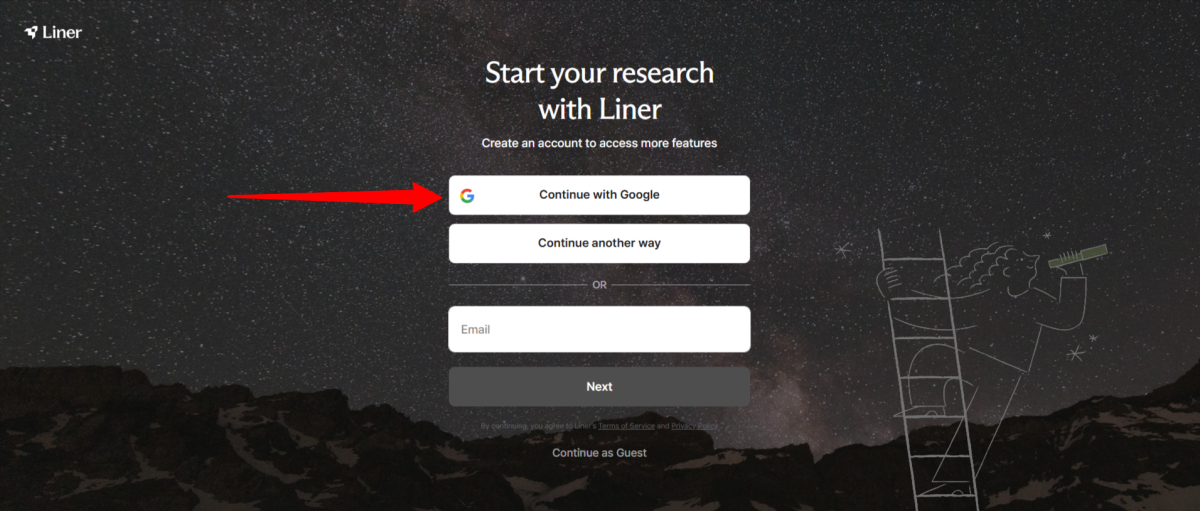
I started by going to getliner.com and creating an account.
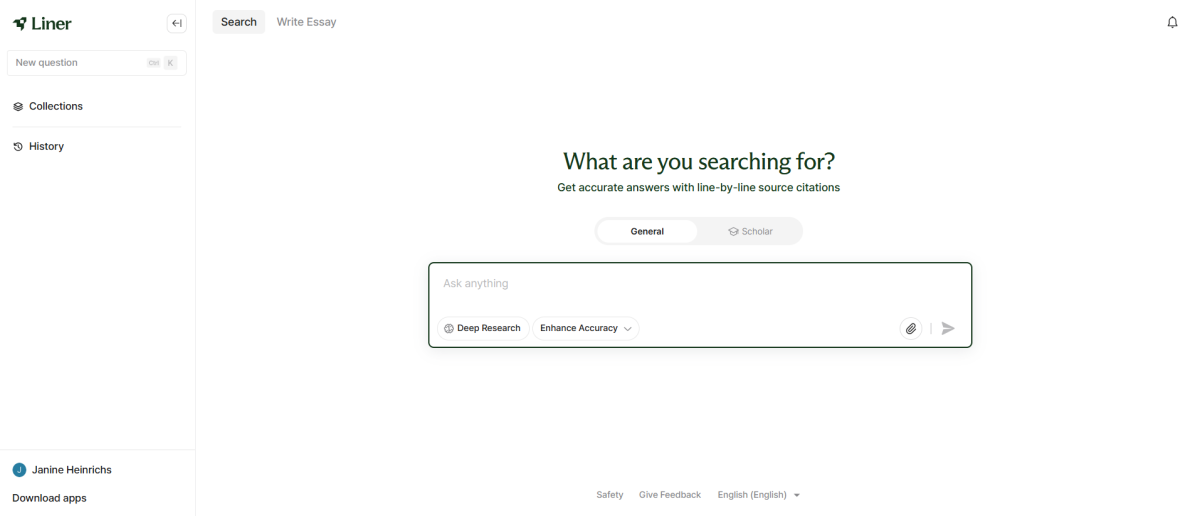
Once my account was created, I was taken to the Search feature. This was where I could get accurate answers to my questions with line-by-line source citations.

On the top left, I could also select “Write Essay.” This allowed me to draft an essay in various formats (APA, MLA, or Chicago) and upload previous essays to create a unique tone of voice.
Step 2: Choose the Search Type
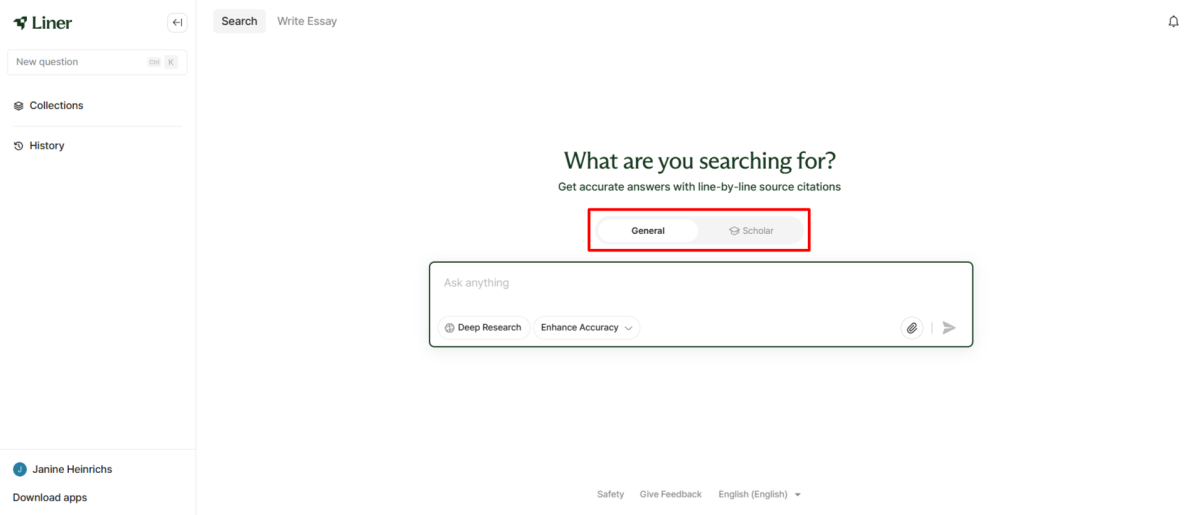
Back in Liner’s Search feature, there were two ways I could search:
- General for searching across the web.
- Scholar for searching across academic papers.
I kept mine on General since I was looking for real-world information rather than peer-reviewed studies.
Step 3: Toggle On/Off Deep Research

Within the search bar, I could toggle Deep Research on or off. Turning this on allowed me to generate in-depth reports. I decided to turn Deep Research on.
Step 4: Select an AI Model

Next to that, I chose my AI model with the two main ones being:
- Liner Pro for more references and greater relevance.
- Liner Pro Reasoning to form conclusions through smart thinking.
What I love about Liner is that it doesn’t just offer its own models to use. It integrates multiple AI models from companies like OpenAI and Google:
- OpenAI o4-mini
- GPT-4.1
- Claude 4 Opus
- Claude 4 Sonnet
- Gemini 2.5 Pro
- Gemini 2.5 Flash
Sometimes, you might want to use the GPT-4 integration for complex analysis. Other times, you may want to switch to a different model for summarizing dense academic papers.
I wanted to try one of the Liner models, so I chose Liner Pro Reasoning as it was labelled the best option.
Step 5: Ask Liner a Question
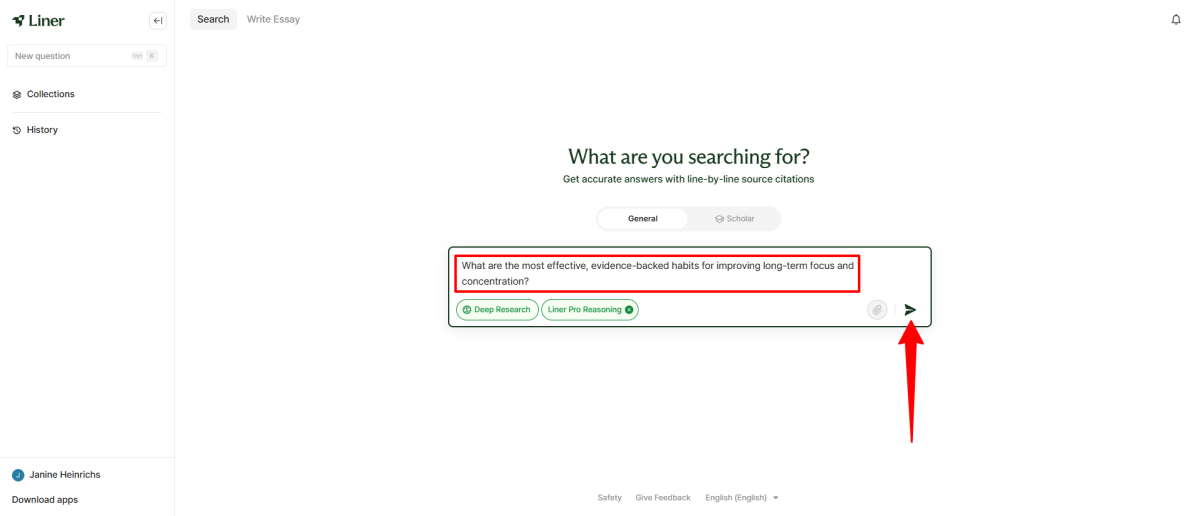
I gave Liner the following question with Deep Research turned on and the Liner Pro Reasoning model selected and hit enter:
“What are the most effective, evidence-backed habits for improving long-term focus and concentration?”
When using Liner for research, it’s important not to treat it like Google. Be specific with your questions.
For example, instead of searching “climate change effects,” ask things like “What are the documented effects of rising sea levels on coastal agriculture in the last decade?” The results will be much more targeted.
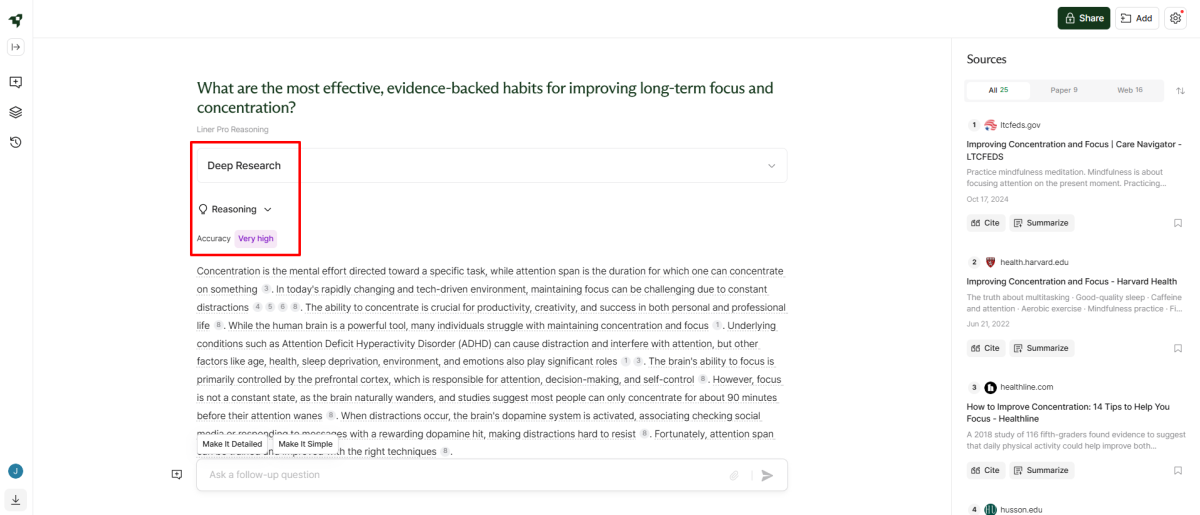
It only took seconds for Liner to generate an in-depth report on the topic.
At the top, it showed its step-by-step research process and reasoning. The information even received an accuracy rating (in my case, very high).
Step 6: Select a Line

What stood out to me the most about Liner (compared to other LLMs I’ve used) was its line-by-line source citations. While the right panel normally shows a list of all the sources gathered for the research, selecting one of the lines reveals the sources used for that specific sentence and why it was used.
Step 7: Create a Mind Map

At the bottom of the generated research was the option to turn the information into a Mind Map or Flowchart. There were also some follow-up questions Liner generated that I could ask, as well as export options.
I selected the Mind Map option to visualize how the concepts are connected.

A few seconds later, Liner turned my research into a Mind Map! The information was neatly organized, making it easy to see connections between key points at a glance.
Overall, Liner made the research process not only fast but also visual. It turned my research into a clean and organized Mind Map that helped me understand and retain complex information more easily.
Top 3 Liner Alternatives
Here are the best Liner alternatives I’d recommend.
You.com
The first Liner alternative I’d recommend is You.com. It’s a conversational AI search engine that helps find answers, summarize content, and gather insights from the web.
Both Liner and You.com are strong options for students, researchers, and professionals who need fast and reliable information. They quickly generate summaries with sources.
However, Liner stands out with its focus on academic and professional research. You’ll get line-by-line source citations and highlighting tools. Liner’s Scholar Mode and Deep Research features make it especially valuable for literature reviews and academic projects.
Meanwhile, You.com focuses on conversational AI for a wider range of users. It’s great for generating fast answers in a chatbot-style format.
Choose Liner for deep research, trusted sources, and smart organization. Otherwise, choose You.com for more of a general chat-style search.
Read my You.com review or visit You.com!
Perplexity
The next Liner alternative I’d recommend is Perplexity. Perplexity is my go-to AI search engine for research. It’s an intuitive AI platform used for research that gives you fast, accurate answers with sources. It’s perfect for anyone wanting immediate access to trustworthy information.
Both platforms give you powerful AI research capabilities. You’ll get source citations and summarization, making them excellent choices for students, researchers, and professionals.
However, Perplexity stands out with its strong focus on retrieving up-to-date web data, news, and academic sources. You can choose from multiple AI models (such as GPT-4.1 and Claude 4.0 Sonnet) and organize your content into collections.
Meanwhile, Liner distinguishes itself by consistently delivering the fastest, most accurate answers in benchmark tests. It often outperforms Perplexity in factual accuracy and academic credibility. Liner’s advanced features (like Scholar Mode) make it especially strong for academic and in-depth research.
For deep academic research and incredible accuracy, choose Liner. For access to real-time information, flexible AI model selection, and a clean interface, choose Perplexity!
Read my Perplexity review or visit Perplexity!
Andi
The final Liner alternative I’d recommend is Andi. Andi is another AI search engine that provides direct answers and explanations in a chat interface rather than just a list of links. You’ll get AI-generated summaries and visual results in a clean, ad-free search experience.
Both platforms use advanced AI models to deliver accurate, up-to-date information for efficient research. They also support a conversational approach to retrieving information, where you can ask questions in natural language and get instant answers.
On the one hand, Andi stands out with its focus on ad-free search results and a visual interface that presents information in easy-to-digest cards and images. It’s designed to feel like a conversation with a knowledgeable friend. You can also quickly cross-reference results with other search engines if needed.
Meanwhile, Liner stands out with its in-depth research with sources and support for highlighting, annotating, and summarizing. Liner is also highly regarded for its research accuracy.
For advanced research tools and summaries, choose Liner. For quick, clear answers in a simple, chat-like search, choose Andi!
Liner Review: The Right Tool For You?
After using Liner, I can confidently say it’s one of the most accurate and useful AI tools I’ve tried for serious research.
Not only did it generate well-sourced answers, but it also created visual Mind Maps in seconds to break down the information into clear ideas. This made it so much easier for me to understand complex topics and stay organized without wasting time digging through endless tabs.
If you often work on things like research papers and need trusted sources, Liner is a great choice. I loved how seamless it felt across desktop and mobile, and the Deep Research feature made me feel like I had a personal research assistant.
However, Liner might not be for everyone. If you just need quick, chat-style answers, one of these alternatives might suit you better:
- You.com is best for quick chats, summaries, and writing help.
- Perplexity is best for quick, up-to-date research with flexible AI models and a clean layout.
- Andi is best for simple, visual, ad-free searching with quick answers in a chat-style format.
If you want something that combines research accuracy, speed, and organization, then Liner is for you.
Thanks for reading my Liner review! I hope you found it helpful.
Liner offers the basic model for free. Try it for yourself and see how you like it!
Frequently Asked Questions
Is Liner trustworthy?
Liner is a trustworthy AI research tool that consistently scores high in global accuracy benchmarks and gives source-backed answers.
Is Liner reliable for research?
Liner is very reliable for research. It consistently ranks first in accuracy benchmarks such as OpenAI’s SimpleQA with a score of 93.7, and delivers source-backed answers for every query. It’s a reliable tool for students, academics, and professionals seeking trustworthy information.
Is Liner Chatgpt free?
Liner is not a free alternative to ChatGPT, but it does offer a free plan with basic research. Feel free to upgrade to one of the paid plans for unlimited answers with deep research and no ads.
How do I cancel my Liner subscription?
To cancel your Liner subscription, visit the settings page on your account and follow the instructions to manage or cancel your plan. If you encounter issues, you can also contact Liner’s support team for assistance.














